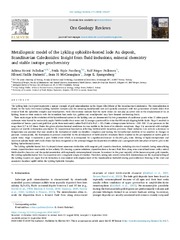| dc.contributor.author | Strmic Palinkas, Sabina | |
| dc.contributor.author | Forsberg, Frida | |
| dc.contributor.author | Pedersen, Rolf B. | |
| dc.contributor.author | Stubseid, Håvard Hallås | |
| dc.contributor.author | McClenaghan, Seán H. | |
| dc.contributor.author | Spangenberg, Jorge E. | |
| dc.date.accessioned | 2024-10-09T13:42:07Z | |
| dc.date.available | 2024-10-09T13:42:07Z | |
| dc.date.issued | 2024-09-10 | |
| dc.description.abstract | The Lykling lode Au deposit represents a unique example of gold mineralization in the Upper Allochthone of the Scandinavian Caledonides. The mineralization is hosted by the Early Ordovician Lykling Ophiolite Complex and the intruding trondhjemite unit and spatially associated with two generations of mafic dykes that crosscut both the ophiolitic complex and trondhjemite. Field observations indicate that the mafic dykes did not play an active role in the emplacement of Au at Lykling, however their contacts with the immediate host rocks (i.e., gabbro and trondhjemite) may have focused ore-forming fluids.<p>
<p>Three main stages in the evolution of the hydrothermal system in the Lykling area are documented by two generations of auriferous quartz veins: 1) older quartz-carbonate veins hosted by moderately angled brittle-ductile shear zones and 2) younger quartz-sulfide veins that fill steeply dipping brittle faults. Stage 1 resulted in deposition of barren quartz and gold-free pyrite from moderately saline NaCl-CaCl2-H2O ± CO2 fluids at temperatures between ∼310–330 °C and pressures in the range from 2.7 to 3.5 kbars. Under the given physicochemical conditions Au was mobile in the form of its chloride complexes. Stage 2 is associated with multiple episodes of ductile deformation punctuated by concomitant brecciation reflecting brittle-ductile transition processes. Fluid inclusion data reveals a decrease in temperature and pressure that may result in the formation of stable Au-bisulfide complexes and making the hydrothermal mobility of Au sensitive to changes in pressure. Consequently, the fluctuation in pressure controlled by the development of brittle-ductile structures likely resulted in the precipitation of native gold in quartz veins. Stage 3 represents a pure brittle event which is accompanied by a significant decrease in the fCO2/fS2 ratio. Mixing of higher-temperature and moderate-salinity fluids with cooler fluids has been recognized as the principal trigger for deposition of sulfides and a paragenetically late phase of native gold in the Lykling hydrothermal system.<p>
<p>The Lykling ophiolite-hosted lode Au deposit shows numerous similarities with orogenic gold deposits elsewhere, including structural controls during mineralizing events, deposition from moderately to low salinity CO2-bearing aqueous solutions, deposition from a focused fluid flow along trans-crustal fault zones with a mixed brittle-ductile character and the spatial association with regionally metamorphosed terranes. In contrast to the great majority of the known orogenic gold deposits, the Lykling ophiolite-hosted lode Au deposit records a magmatic origin of volatiles. Therefore, taking into consideration field relationships and the regional setting of the Lykling deposit, we argue that its formation is concomitant with emplacement of the Sunnhordland Batholith during post-collisional thinning of the crust and associated localized uplift within the Lykling Ophiolite Complex. | en_US |
| dc.identifier.citation | Strmic Palinkas, Forsberg, Pedersen, Stubseid, McClenaghan, Spangenberg. Metallogenic model of the Lykling ophiolite-hosted lode Au deposit, Scandinavian Caledonides: Insight from fluid inclusions, mineral chemistry and stable isotope geochemistry. Ore Geology Reviews. 2024;173 | en_US |
| dc.identifier.cristinID | FRIDAID 2306707 | |
| dc.identifier.doi | 10.1016/j.oregeorev.2024.106227 | |
| dc.identifier.issn | 0169-1368 | |
| dc.identifier.issn | 1872-7360 | |
| dc.identifier.uri | https://hdl.handle.net/10037/35150 | |
| dc.language.iso | eng | en_US |
| dc.publisher | Elsevier | en_US |
| dc.relation.journal | Ore Geology Reviews | |
| dc.relation.projectID | EU – Horisont Europa (EC/HEU): MinExTarget | en_US |
| dc.relation.projectID | info:eu-repo/grantAgreement/EC/H2020/?/?/?/ MinExTarget?/ | en_US |
| dc.rights.accessRights | openAccess | en_US |
| dc.rights.holder | Copyright 2024 The Author(s) | en_US |
| dc.rights.uri | https://creativecommons.org/licenses/by/4.0 | en_US |
| dc.rights | Attribution 4.0 International (CC BY 4.0) | en_US |
| dc.title | Metallogenic model of the Lykling ophiolite-hosted lode Au deposit, Scandinavian Caledonides: Insight from fluid inclusions, mineral chemistry and stable isotope geochemistry | en_US |
| dc.type.version | publishedVersion | en_US |
| dc.type | Journal article | en_US |
| dc.type | Tidsskriftartikkel | en_US |
| dc.type | Peer reviewed | en_US |


 English
English norsk
norsk
